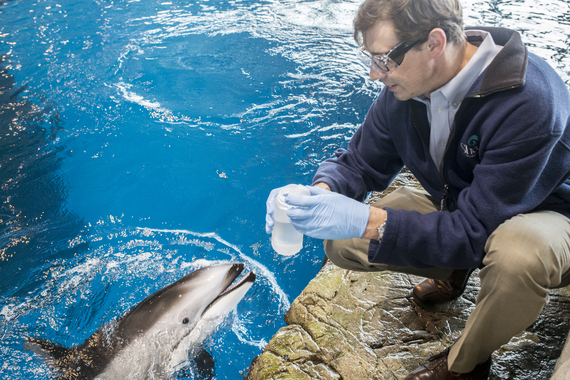For a bunch of air-breathers, those of us trusted to keep our animals healthy and thriving are up to our "gills" as we're tasked to think about our water quality at Shedd Aquarium. As we near the end of National Water Quality Month, it's important to reflect and think about why water quality is a critical issue 365 days a year, not just during the month of August.

Allen LaPointe, Vice President of Environmental Quality at Shedd Aquarium, takes a sample of the water in the Abbott Oceanarium.
Animals - whether in an aquarium environment or in a native environment - have no control over the quality of the water around them. We do. As a result, we have an obligation to ensure the very best water quality possible. At Shedd, this means putting the right water for the right purpose in the right place. That's no small task! Water comes in all forms at Shedd - clear, cloudy, salt, fresh, warm, cold - the list goes on! These conditions are carefully analyzed and adjusted as needed to create the best home for the animals that spend their lives swimming inside it.
How do we do that? We start in our own backyard, in the same waters of Lake Michigan that millions of people in the Chicagoland area use daily to drink, clean and cook with. All water that we use for our habitats at Shedd is first put through a massive charcoal filter - think about a home water filtration system, and multiply that by about 10,000. That's where the water for our habitats begins its journey. This removes impurities like chlorine, which can be poisonous to our amphibians and fish. From there, we apply a variety of techniques to purify this water, like running it through a reverse osmosis membrane - a very specialized filter that removes dissolved salts and other molecules that even charcoal can't capture. This process is necessary in our Amazon Rising habitats because Amazon river water in the native habitat is known to be very low in dissolved salts and we must replicate that for animals that have evolved in that type of water.
But that's just the start. Next, we must ensure the water is the right mix for the right habitat. Our Caribbean Reef exhibit - home to rescued sea turtle Nickel, stingrays and bonnethead sharks - requires added salts and warmer temperatures. For habitats that house endangered coral, calcium is added and phosphorus is filtered in to ensure a quality environment. These additions, subtractions and changes to the variety of environments are constantly monitored by a team of Environmental Quality Technicians - and supported by more than 60 volunteers! - who continuously test the water inside the habitats in our Environmental Quality Lab.
Through this research, we are constantly applying what we have learned and adjusting the way we do things. Over the past few years, we been exploring whether we could "recycle" some water from habitats within Shedd without impacting the health of our animals. Through careful testing, we have been able to reduce our water footprint by transferring water from some of our gallery spaces into our Oceanarium, therefore a decrease in the amount of water we take in and put out.
Beyond the day-to-day monitoring of water quality within Shedd, we're diving even deeper. While the chemical composition is important to keeping our animals healthy, we're also closely examining the biological communities that share the water with our animals. The Aquarium Microbiome Project has begun studying the vast yet microscopic ecological communities within Shedd's water. This includes closely examining how these tiny bacteria, viruses and fungi interact with our animals, and the results have been fascinating. While we sometimes think of these communities as simply "germs," we have found they can be incredibly beneficial, if not essential, to the health of our animals. In fact, we recently studied the microbiotic makeup of the water in our Stingray Touch experience. Despite these animals being touched by more than 400,000 human hands through the course of the season, the results proved this experience has no negative effects on the animals. It actually improved some of the indicators of health and welfare like heart rate!
At Shedd Aquarium caring for the quality of water animals live in and depend on does not stop at the front doors. It's extremely important that we as a species are constantly aware of our impact on the water systems we - and all animals - rely on around the world. Choosing public transportation, participating in beach clean-ups, avoiding products that contain microbeads and refraining from disposing of medications down the drain are all examples of small but important steps we can take to improve water quality at home, and by extension, around the world.
Bill Van Bonn, DVM, is Shedd Aquarium's vice president of animal health. With more than 25 years of clinical veterinary experience, Dr. Van Bonn strengthens the aquarium's established animal care and health expertise, overseeing its diverse aquatic medicine initiatives as well as furthering innovative veterinary science at Shedd. Dr. Van Bonn specializes in preventive medicine and enhanced clinical veterinary services for aquatic animals, with a focus on marine mammals. At Shedd, he focuses on providing top-quality care and applying his knowledge of animal health to conservation of their counterparts in the wild. He also oversees the aquarium's Microbiome Project.